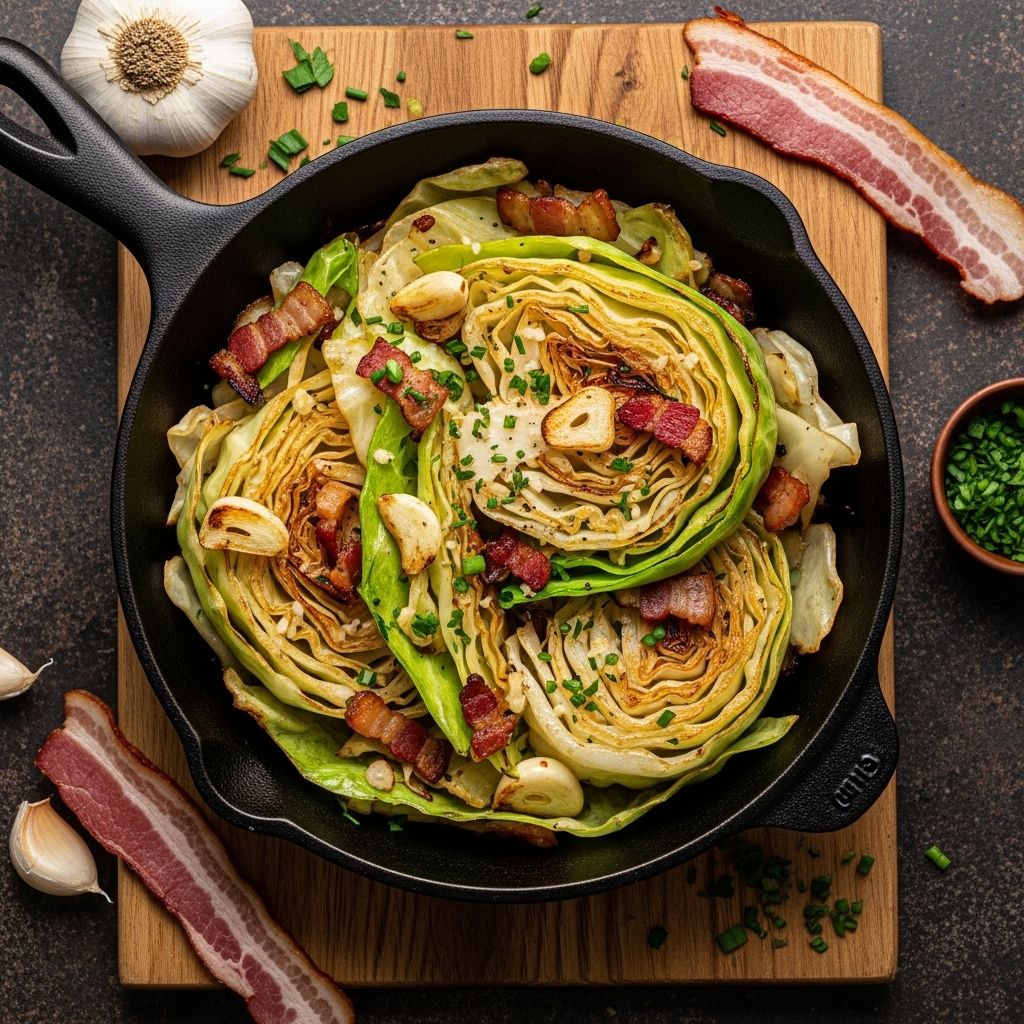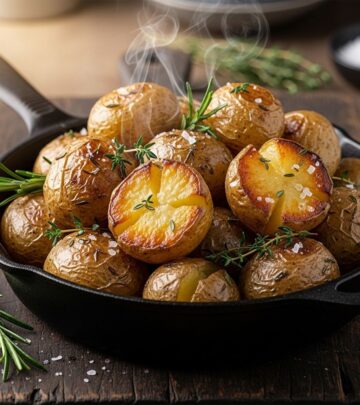Fried Cabbage Recipe: 5 Easy Variations With Bacon & Garlic
A delicious comfort food combining crispy bacon with tender cabbage for the perfect side dish

Image: HearthJunction Design Team
Savory Fried Cabbage with Bacon, Onion, and Garlic
There’s something incredibly satisfying about the combination of crispy bacon, tender cabbage, sweet onions, and aromatic garlic all melded together in one pan. This fried cabbage recipe isn’t just delicious—it’s a celebration of how simple ingredients can transform into something extraordinary with minimal effort. Whether you’re looking for a hearty side dish to complement your main course or a comforting bowl to enjoy on its own, this recipe delivers tremendous flavor without complicated techniques or hard-to-find ingredients.
What Makes This Fried Cabbage Special
What sets this recipe apart is the beautiful layering of flavors. The process begins with rendering fat from the bacon, which then becomes the foundation for sautéing the onions and garlic. When the cabbage joins the party, it soaks up all those savory elements while maintaining a pleasant tender-crisp texture. The dish strikes the perfect balance between richness from the bacon and the natural sweetness of the cabbage, creating a side dish that often steals the spotlight from the main course.
Ingredients You’ll Need
The beauty of this recipe lies in its simplicity. With just a handful of basic ingredients, you can create a dish that delivers incredible depth of flavor:
- 6 slices bacon, chopped into small pieces
- 1 large onion, diced
- 2 cloves garlic, minced
- 1 large head cabbage, cored and sliced
- 1 teaspoon salt, or to taste
- 1/2 teaspoon ground black pepper, or to taste
- Optional: pinch of sugar to enhance the natural sweetness of the cabbage
- Optional: red pepper flakes for a spicy kick
Kitchen Tools Required
This recipe doesn’t require any specialized equipment, making it accessible for cooks of all levels. Here’s what you’ll need:
- A large skillet or Dutch oven (12-inch is ideal)
- A sharp knife for chopping bacon and slicing cabbage
- Cutting board
- Wooden spoon or heat-resistant spatula for stirring
- Measuring spoons
Step-by-Step Instructions
Preparing Your Ingredients
Before you begin cooking, it’s helpful to have all your ingredients prepped and ready to go. This French cooking concept called mise en place (everything in its place) makes the cooking process much smoother, especially for quick-cooking dishes like this one.
- Prepare the bacon: Chop the bacon into small pieces about 1/2-inch in size. Smaller pieces will distribute more evenly throughout the dish.
- Prep the vegetables: Dice the onion into small, uniform pieces. Mince the garlic cloves finely. For the cabbage, remove the tough outer leaves, cut it in half, and remove the core. Then slice the cabbage into thin strips about 1/4 to 1/2 inch wide.
- Measure seasonings: Have your salt, pepper, and any optional seasonings ready nearby.
Cooking Process
- Cook the bacon: Place your large skillet over medium heat. Add the chopped bacon and cook until it becomes crispy and has released its fat, about 5-7 minutes. Stir occasionally to ensure even cooking.
- Sauté aromatics: Once the bacon is crispy, add the diced onion to the pan with the bacon and bacon grease. Cook until the onion becomes translucent and starts to caramelize slightly, about 3-4 minutes. Then add the minced garlic and cook for another 30 seconds until fragrant. Be careful not to burn the garlic as it can become bitter.
- Add the cabbage: Add the sliced cabbage to the skillet. You might need to do this in batches if your pan is not large enough. As the cabbage begins to wilt, it will reduce in volume, making room for more.
- Season and cook: Sprinkle the salt and pepper over the cabbage mixture. If using optional ingredients like sugar or red pepper flakes, add them now. Stir everything together to ensure the cabbage is well-coated with the bacon fat and seasonings.
- Continue cooking: Cook the cabbage, stirring occasionally, until it reaches your desired tenderness. This typically takes about 10-15 minutes. Some people prefer their cabbage with a bit of crunch, while others enjoy it completely soft. Adjust the cooking time accordingly.
- Taste and adjust: Before serving, taste the dish and adjust the seasoning if necessary. You may want to add more salt, pepper, or other seasonings based on your preference.
Recipe Variations
The beauty of this fried cabbage recipe is its versatility. Here are several delicious variations you can try:
Southern-Style Fried Cabbage
For a traditional Southern twist, add a pinch of sugar and a splash of vinegar (apple cider vinegar works wonderfully). This creates a subtle sweet-and-sour profile that complements the bacon perfectly.
Spicy Fried Cabbage
Add 1/4 to 1/2 teaspoon of red pepper flakes while sautéing the onions, or incorporate a diced jalapeño pepper for a more pronounced heat. A dash of hot sauce just before serving also works wonders.
German-Inspired Version
Add 1 tablespoon of caraway seeds when you add the cabbage, and finish the dish with a splash of apple cider vinegar. This gives the dish a flavor reminiscent of German sauerkraut dishes but with a fresher profile.
Vegetarian Alternative
Skip the bacon and use 3 tablespoons of olive oil or butter instead. Add 1 tablespoon of smoked paprika to impart some of that smokiness you’d get from bacon. Mushrooms make a great addition to this version for extra umami flavor.
Meal Prep Variation
This dish stores well in the refrigerator for up to 3-4 days. For meal prep purposes, you can add protein like smoked sausage or leftover chicken to transform it into a complete one-pan meal.
Serving Suggestions
Fried cabbage with bacon makes an excellent side dish that pairs beautifully with a variety of main courses. Here are some serving ideas:
- Classic pairings: Serve alongside pork chops, roasted chicken, or grilled sausages for a traditional meat-and-vegetable meal.
- Comfort food combos: Pair with meatloaf and mashed potatoes for the ultimate comfort food experience.
- Southern meal: Complete a Southern-themed dinner with cornbread, black-eyed peas, and fried chicken.
- Low-carb option: For those following a low-carb or keto diet, this dish makes a satisfying side that keeps carbohydrates in check while delivering plenty of flavor.
- Make it a main: Serve a larger portion as a main dish with a fried or poached egg on top for a simple yet satisfying meal.
Nutritional Information
While exact nutritional values will vary based on specific ingredients and portion sizes, this dish offers several nutritional benefits worth noting:
- Cabbage: Low in calories yet high in vitamins C and K, fiber, and antioxidants.
- Bacon: Provides protein and contributes to the dish’s savory flavor profile.
- Onions and garlic: Contain compounds with anti-inflammatory and immune-supporting properties.
A typical serving (approximately 1 cup) contains around 150-200 calories, making it a relatively light side dish despite its rich flavor.
Storage and Reheating Tips
One of the advantages of this dish is that it often tastes even better the next day as the flavors have time to meld. Here’s how to store and reheat your leftover fried cabbage:
Refrigeration
Allow the dish to cool completely before transferring it to an airtight container. It will keep well in the refrigerator for 3-4 days.
Freezing
While you can freeze this dish, the texture of the cabbage may change slightly upon thawing. If you choose to freeze it, store in freezer-safe containers for up to 2 months.
Reheating
The best way to reheat this dish is in a skillet over medium heat. Add a splash of water or broth to prevent it from drying out, and stir occasionally until heated through. Microwave reheating works in a pinch—cover the dish with a microwave-safe lid or paper towel and heat in 30-second intervals, stirring between each, until hot.
Why This Recipe Works
Understanding the science behind cooking can help you perfect this dish. Here’s why this method creates such delicious results:
- Rendering bacon fat: Starting with bacon allows its fat to render slowly, creating a flavorful base for the entire dish.
- Layering flavors: By adding ingredients in sequence (bacon, then onions, then garlic, and finally cabbage), each component gets to develop its optimal flavor.
- Caramelization: The natural sugars in the onions and cabbage caramelize slightly during cooking, adding depth and sweetness.
- Fat as flavor carrier: The bacon fat helps distribute the flavors throughout the dish and carries fat-soluble flavor compounds to your taste buds.
Common Mistakes to Avoid
Even simple recipes can go awry. Here are some pitfalls to avoid when making fried cabbage with bacon:
- Overcrowding the pan: If your pan is too crowded, the cabbage will steam rather than fry, resulting in a soggy texture. Work in batches if necessary.
- Cooking the cabbage too long: While softened cabbage is the goal, overcooking can lead to a mushy texture and sulfurous odor.
- Under-seasoning: Cabbage needs adequate salt to bring out its flavor. Don’t be shy with the seasonings.
- Burning the garlic: Garlic burns quickly and develops a bitter taste when overcooked. Add it shortly before the cabbage to prevent burning.
- Using pre-shredded cabbage: Pre-packaged shredded cabbage often lacks the freshness of a whole head and may have preservatives that affect the flavor.
Frequently Asked Questions (FAQs)
Q: Can I make this recipe ahead of time?
A: Yes, this dish actually develops more flavor when made ahead. You can prepare it up to 2 days in advance and reheat it gently on the stovetop when ready to serve.
Q: What type of cabbage works best for this recipe?
A: Green cabbage is traditional and works perfectly, but you can also use savoy cabbage for a more delicate texture or red cabbage for a colorful variation (though it will turn everything purple).
Q: Can I make this recipe vegetarian?
A: Absolutely! Skip the bacon and use olive oil or butter instead. Add a teaspoon of smoked paprika to mimic the smoky flavor that bacon would provide.
Q: My family doesn’t like visible pieces of bacon. Can I remove them after cooking?
A: Yes, you can cook the bacon, remove it from the pan, continue with the recipe using the bacon fat, and then either leave the bacon out entirely or crumble it finely and add it back at the end.
Q: Is this dish keto-friendly?
A: Yes, this dish is naturally low in carbohydrates and high in fat, making it suitable for ketogenic diets. Just be careful with onions as they contain some carbs.
Conclusion
Fried cabbage with bacon, onion, and garlic is a testament to how humble ingredients can create extraordinary flavors when prepared with care. This dish carries the comfort of traditional home cooking while being adaptable to modern tastes and dietary preferences. Whether you’re serving it alongside a Sunday roast or enjoying it as a simple weeknight meal, this recipe promises satisfaction in every bite.
The next time you spot a head of cabbage in the produce section, remember this recipe—it might just become your new favorite way to enjoy this versatile vegetable. With its perfect balance of savory bacon, sweet onions, aromatic garlic, and tender cabbage, this dish proves that sometimes the simplest combinations yield the most memorable results.
References
- https://www.allrecipes.com/recipe/196732/fried-cabbage-with-bacon-onion-and-garlic/
- https://www.allrecipes.com/recipe/272188/fried-cabbage-with-bacon/
- https://www.allrecipes.com/recipe/278101/fried-cabbage-with-bacon-and-garlic/
- https://www.allrecipes.com/recipe/73833/southern-fried-cabbage/
- https://www.allrecipes.com/recipe/23685/fried-cabbage-ii/
Read full bio of Anjali Sayee












